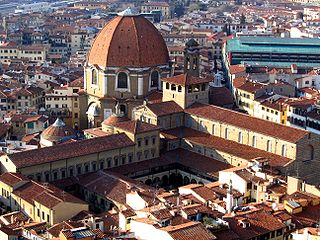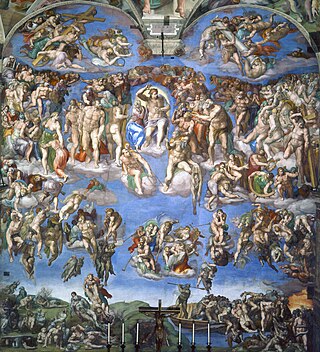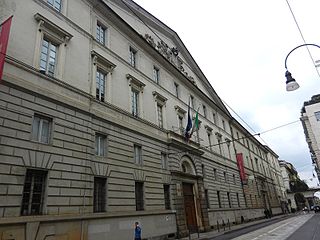Male Back With a Flag is a chalk drawing by Michelangelo Buonarroti, from 1504.
Male Back With a Flag is a chalk drawing by Michelangelo Buonarroti, from 1504.
The painting is a drawing on paper, with dimensions of 19.6 x 27 centimeters. It is in the collection of the Albertina, Vienna. [1]
It was a study for the planned fresco Battle of Cascina . [2]

Michelangelo di Lodovico Buonarroti Simoni, known as Michelangelo, was an Italian sculptor, painter, architect, and poet of the High Renaissance. Born in the Republic of Florence, his work was inspired by models from classical antiquity and had a lasting influence on Western art. Michelangelo's creative abilities and mastery in a range of artistic arenas define him as an archetypal Renaissance man, along with his rival and elder contemporary, Leonardo da Vinci. Given the sheer volume of surviving correspondence, sketches, and reminiscences, Michelangelo is one of the best-documented artists of the 16th century. He was lauded by contemporary biographers as the most accomplished artist of his era.

The Creation of Adam is a fresco painting by Italian artist Michelangelo, which forms part of the Sistine Chapel's ceiling, painted c. 1508–1512. It illustrates the Biblical creation narrative from the Book of Genesis in which God gives life to Adam, the first man. The fresco is part of a complex iconographic scheme and is chronologically the fourth in the series of panels depicting episodes from Genesis.

The Sistine Chapel ceiling, painted in fresco by Michelangelo between 1508 and 1512, is a cornerstone work of High Renaissance art.

The Accademia di Belle Arti di Firenze is an instructional art academy in Florence, in Tuscany, in central Italy.

The Albertina is a museum in the Innere Stadt of Vienna, Austria. It houses one of the largest and most important print rooms in the world with approximately 65,000 drawings and approximately 1 million old master prints, as well as more modern graphic works, photographs and architectural drawings. Apart from the graphics collection the museum has recently acquired on permanent loan two significant collections of Impressionist and early 20th-century art, some of which will be on permanent display. The museum also houses temporary exhibitions. The museum had 360,073 visitors in 2020, down 64 percent from 2019 due to the COVID-19 pandemic, but still ranked 55th in the List of most-visited art museums in the world.

The Innere Stadt is the 1st municipal district of Vienna located in the center of the Austrian capital. The Innere Stadt is the old town of Vienna. Until the city boundaries were expanded in 1850, the Innere Stadt was congruent with the city of Vienna. Traditionally it was divided into four quarters, which were designated after important town gates: Stubenviertel (northeast), Kärntner Viertel (southeast), Widmerviertel (southwest), Schottenviertel (northwest).

I Modi, also known as The Sixteen Pleasures or under the Latin title De omnibus Veneris Schematibus, is a famous erotic book of the Italian Renaissance in which a series of sexual positions were explicitly depicted in engravings.

The Medici Chapels are two structures at the Basilica of San Lorenzo, Florence, Italy, dating from the 16th and 17th centuries, and built as extensions to Brunelleschi's 15th-century church, with the purpose of celebrating the Medici family, patrons of the church and Grand Dukes of Tuscany. The Sagrestia Nuova was designed by Michelangelo. The larger Cappella dei Principi, although proposed in the 16th century, was not begun until the early 17th century, its design being a collaboration between the family and architects.

The Last Judgment is a fresco by the Italian Renaissance painter Michelangelo covering the whole altar wall of the Sistine Chapel in Vatican City. It is a depiction of the Second Coming of Christ and the final and eternal judgment by God of all humanity. The dead rise and descend to their fates, as judged by Christ who is surrounded by prominent saints. Altogether there are over 300 figures, with nearly all the males and angels originally shown as nudes; many were later partly covered up by painted draperies, of which some remain after recent cleaning and restoration.

The Battle of Anghiari (1505) was a planned painting by Leonardo da Vinci in the Salone dei Cinquecento in the Palazzo Vecchio, Florence. Its central scene would have depicted four men riding raging war horses engaged in a battle for possession of a standard at the Battle of Anghiari in 1440.

Cascina is a comune (municipality) in the Province of Pisa in the Italian region Tuscany, located about 60 kilometres (37 mi) west of Florence and about 13 kilometres (8 mi) southeast of Pisa.
Jashore Sadar is an upazila of Jashore District in the Division of Khulna, Bangladesh. Its administrative centre is the city of Jashore, which is also the centre of the district.

Epifania is a cartoon or full-scale drawing in black chalk by Michelangelo, produced in Rome around 1550–53. It is 2.32 metres tall by 1.65 m wide, and is made up of 26 sheets of paper.

The Battle of Cascina is a never-completed painting in fresco commissioned from Michelangelo for the Palazzo Vecchio in Florence. He created only the preparatory drawing before being called to Rome by Pope Julius II, where he worked on the Pope's tomb; before completing this project, he returned to Florence for some months to complete the cartoon.

Tommaso dei Cavalieri was an Italian nobleman, who was the object of the greatest expression of Michelangelo's love. Michelangelo was 57 years old when he met Cavalieri in 1532. The young noble was exceptionally handsome, and his appearance seems to have fit the artist's notions of ideal masculine beauty, for Michelangelo described him as "light of our century, paragon of all the world". The two men remained close to each other throughout their lives and Cavalieri was present at the artist's death.
Assiano is a rural district ("quartiere") of Milan, Italy, part of the Zone 7 administrative division. It is a border district, at the western end of the city area. Before being annexed to Milan, it was an autonomous comune, except for a brief period (1808-1816) when it was included in Cusago.

The Accademia Albertina di Belle Arti is an institution of higher education in Turin, Italy

The Punishment of Tityus is a drawing by the Italian Renaissance artist Michelangelo.

The Rothschild Bronzes, also known as the Michelangelo Bronzes, are a pair of 16th century statuettes, each depicting a nude male figure riding a mythological animal, usually identified as a panther. Mirroring each other in pose, the nude men are distinguished by age, one young, the other bearded. The younger man is 76.6 cm, the other almost 90 cm high. The sculptures are unsigned and the figures and panthers have been separately cast. The bronzes were displayed to the public at the Fitzwilliam Museum, University of Cambridge, from February to August 2015 with an attribution to Michelangelo. If the attribution is correct, Michelangelo would have made the bronzes around 1506 to 1508, before the painting of the Sistine Chapel ceiling but after the marble statue of David. The sculptures would be the only autograph bronze works by Michelangelo to have survived.

Bathers at San Niccolò is a large oil painting by Domenico Cresti, known as Domenico Passignano, signed and dated 1600. The Mannerist painting depicts men bathing in the River Arno near the crenelated Tower of San Niccolò in Florence.